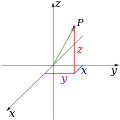Dimension

Dimensions are the way we see, measure and experience our world, by using up and down, right to left, back to front, hot and cold, how heavy and how long, as well as more advanced concepts from mathematics and physics. One way to define a dimension is to look at the degrees of freedom, or the way an object can move in a specific space. There are different concepts or ways where the term dimension is used, and there are also different definitions. There is no definition that can satisfy all concepts.
In a vector space [math]\displaystyle{ V }[/math] (with vectors being "arrows" with directions), the dimension of [math]\displaystyle{ V }[/math], also written as [math]\displaystyle{ \dim(V) }[/math],[1] is equal to the cardinality (or number of vectors) of a basis of [math]\displaystyle{ V }[/math][2][3] (a set which indicates how many unique directions [math]\displaystyle{ V }[/math] actually has). It is also equal to the number of the largest group of straight line directions of that space. "Normal" objects in everyday life are specified by three dimensions, which are usually called length, width and depth. Mathematicians call this concept Euclidean space.
Dimensions can be used to measure position too. The distance to a position from a starting place can be measured in the length, width and height directions. These distances are a measure of the position.
In some occasions, a fourth (4D) dimension, time, is used to show the position of an event in time and space.
Other Dimensions
In modern science, people use other dimensions. Dimensions like temperature and weight can be used to show the position of something in less simple spaces. Scientist study those dimensions with dimensional analysis.
Mathematicians also use dimensions. In mathematics, dimensions are more general. Dimensions in mathematics might not measure things in the world. The rules for doing arithmetic with dimensions in mathematics might be different than usual arithmetic rules.
Dimensions and vectors
Vectors are used to show distances and directions. Vectors are often used in engineering and science, and sometimes in mathematics.
A vector is a list of numbers. There is one number for each dimension. There are arithmetic rules for vectors.
For example, if Jane wants to know the position of Sally, Sally can give Jane a vector to show the position. If Jane and Sally are in the world, there are three dimensions. Therefore, Sally gives Jane a list of three numbers to show her position. The three numbers in the vector Sally gives Jane might be:
- Sally's distance north of Jane
- Sally's distance east of Jane
- Sally's height above Jane
Related pages
- 3D
- 4D
- Hypercube, generalization of square and cube beyond three dimensions
- Minkowski spacetime, a four-dimensional manifold
- Space-time
References
- ↑ "Comprehensive List of Algebra Symbols". Math Vault. 2020-03-25. Retrieved 2020-09-07.
- ↑ Weisstein, Eric W. "Dimension". mathworld.wolfram.com. Retrieved 2020-09-07.
- ↑
Dimension Media
The complex plane can be mapped to the surface of a sphere, called the Riemann sphere, with the complex number 0 mapped to one pole, the unit circle mapped to the equator, and a point at infinity mapped to the other pole.
"Basis and Dimension". people.math.carleton.ca. Archived from the original on 2021-12-21. Retrieved 2020-09-07.








